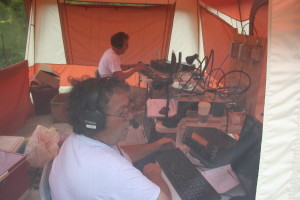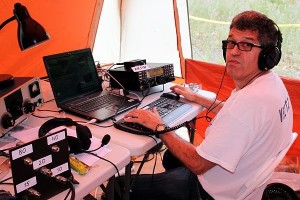The WRTC2014 Station Test was a complete success. Over 120 volunteers came together to construct 25 stations in one day. The operating teams all kept the stations on the air for the contest period. The live scoreboard provided regular updates of how everyone was doing.
More than just station testing, there was a radio contest going on as well. Some of the teams were more serious than others, but all reported having fun and being amazed at what 100 watts and simple antennas could do.
In spite of poor and disturbed propagation conditions, the 25 test stations made 33,034 valid QSOs (after dupes). 21 of the 25 stations had more than 1000 contacts. 77% of the contacts were made on CW. Multiplier chasing should definitely be part of a winning strategy.
In addition to working the contest, we asked the operators of the test stations to spend various times during the contest calling CQ with a specified antenna configuration. This may have hurt their score, but it provided valuable data for evaluating the equality of the operating sites.
The logs provided a test run for the log checking process. Each log was checked and scored according to the WRTC2014 rules using software by Tree, N6TR. The close race at the top gives an indication of just how exciting the real WRTC competition will be next year!
Station Test Results
| CALLSIGN | SCORE | Tot QSOs | CW QSOs | SSB QSOs | HQ Mul | DX Mul | Radios | Operators |
| W1UE | 2,169,035 | 1,959 | 1,522 | 437 | 157 | 192 | 2 | W1UE W1KM |
| N2NT | 2,115,954 | 2,032 | 1,357 | 675 | 150 | 192 | 2 | N2NT N2NC |
| AK1W | 1,538,226 | 1,708 | 1,467 | 241 | 125 | 166 | 2 | VA2WA VE2TZT |
| W1SJ | 1,370,958 | 1,929 | 1,466 | 463 | 99 | 147 | 2 | W1SJ K1LI |
| K1BG | 1,308,528 | 1,332 | 937 | 395 | 136 | 176 | 2 | K1BG NM1C KB1YJI NR1G |
| K1ZD | 1,302,125 | 1,528 | 1,265 | 263 | 121 | 154 | 2 | K1ZZ K1CC K0TG |
| K6ND | 1,228,568 | 1,632 | 1,182 | 450 | 110 | 143 | 2 | K3JO K6ND K1VR NB1U K6NDV |
| K1GQ | 1,172,888 | 1,449 | 1,334 | 115 | 121 | 150 | 2 | K1GQ W2RU W2CS K1AR WA1Z |
| W1UJ | 1,169,805 | 1,406 | 1,178 | 228 | 129 | 144 | 2 | KB1H W1UJ K1RAX K1EBY N1WK K1ZE NR1X NB1U |
| N3AD | 1,130,002 | 1,536 | 1,084 | 452 | 109 | 142 | 2 | N3AD W1GD |
| KE1J | 1,029,436 | 1,399 | 1,152 | 247 | 100 | 144 | 2 | KE1J W1VE |
| K1RX | 1,010,786 | 1,355 | 1,031 | 324 | 93 | 145 | 1 | K1RX W1CU |
| N1SV | 982,146 | 1,419 | 792 | 627 | 122 | 131 | 2 | N1SV KM1P N2KW |
| AD1T | 946,080 | 1,459 | 1,238 | 221 | 86 | 130 | 2 | AE1P K1QX K1ZO N1KWF W1WWW |
| W1EQ | 918,537 | 1,432 | 1,056 | 376 | 97 | 126 | 2 | W1EQ K1ZE N3XF K1RAX |
| NJ1F | 911,212 | 1,519 | 1,231 | 288 | 90 | 124 | 2 | NJ1F K1RQ WC2L K1EP KB1W WA1ZAM |
| K9ES | 837,536 | 1,323 | 1,131 | 192 | 103 | 121 | 2 | K9ES AD4ES K1ST |
| NI1L | 703,120 | 1,079 | 891 | 188 | 101 | 119 | 2 | NI1L N2MG K3ZJ |
| W1MA | 671,008 | 1,081 | 987 | 94 | 95 | 113 | 2 | W1MA N2MM |
| NB1N | 653,045 | 1,103 | 976 | 127 | 96 | 115 | 2 | NB1N K9HI K1IB N2JFS |
| WB1Z | 617,874 | 1,064 | 880 | 184 | 89 | 112 | 2 | AA1YW KK1W W1EQO W1MSW W3SM N1SR NV1Q |
| AA3K | 403,684 | 830 | 545 | 285 | 74 | 98 | 2 | AA3K K3FT WI3Y |
| W1CLA | 294,038 | 639 | 256 | 383 | 67 | 91 | 1 | K1MBO K1VR K5ZD KB1REQ N1QD |
| W1HH | 163,149 | 493 | 410 | 83 | 51 | 68 | 1 | W1STT WO1N WC1M KB1ST |
| N1JD | 134,691 | 328 | 217 | 111 | 68 | 71 | 1 | N1JD N1OXA |
Operating Experiences
The winning team of W1UE and W1KM used a full two-operator and two-transmitter set up that enabled them to keep both stations active for the full 24 hours. In the end, it was a few extra multipliers that earned them the victory. Both pulled double duty by also serving as key members of the station building effort. Dennis, W1UE, was the dispatch manager for the southern warehouse while Greg, W1KM, took on responsibility for getting 4 stations assembled. These guys were tired when it was over!
The second place team of N2NT and N2NC drove up from New Jersey to help with the test. Andy, N2NT, is a member of the organizing committee and responsible for the rules and station configuration. This was a great opportunity for him to gain an understanding of what the competitors will be facing.
VA2WA and VE2TZT drove down from Quebec to try their hand at a WRTC station. They also brought a competitive radio and switching setup that helped them to a third place finish.
W1SJ and K1LI teamed up to create an operating team. Network problems caused them to have a late start in the contest, but they did well enough to finish in fourth.
K9ES and AD4ES came up from Florida to try their hand at operating. Several FRC members including N3AD, AA3K, and N2MM also drove up to contribute some operating time.
Some of the less serious efforts did use the DX Cluster to help find contacts. This will not be permitted during WRTC2014, but it enabled the station test ops to make more QSOs and have fun.
Jay, W1UJ, reported, “The antennas worked well. The tribander has large front to side and small front to back. Perfect for this operation. The sides null some loud signals, including other WRTC test station nearby.”
Not everything went perfectly for the competitors.The K1ZD team lost the 20 meter section of their Triplexer and had a radio failure. The W1EQ ops lost their triplexer early on Saturday. They continued on with one radio on the tribander and one on the 40/80 meter dipoles. A radio communication problem prevented software control of one radio. The KE1J team didn’t have a triplexer, but did the best they could using the 40m dipole on 15 meters. One of the K3 radios at W1UJ stopped working during the contest. Jay called his wife, had her email a software update, then installed it in the field to restore the radio. Wow!
We had some rain showers pass through. Stations located to the south had some brief, but very intense, periods of rain. The tents did their job and there was no adverse impact to the operators or equipment.
There were no antenna or generator failures during the competition.
In his email thanking all of the volunteers, WRTC2014 Chairman Doug Grant, K1DG, summarized the effort:
“I’d like to thank everyone who participated this year and helped make the Station Test last weekend a success. We got 25 identical stations on 12 different properties built in one day without incident. All the stations got on the air and made lots of QSOs. Then it all came back down without incident and all the towers, antennas, tents, etc., are safely stored away.”
For more of the story including station logs, photos and videos, please visit the 2013 Station Test page.
Note: We will be sending out QSLs to all DX stations via the bureau and we’ll send US cards direct after bundling them together. That may not happen for several months.



